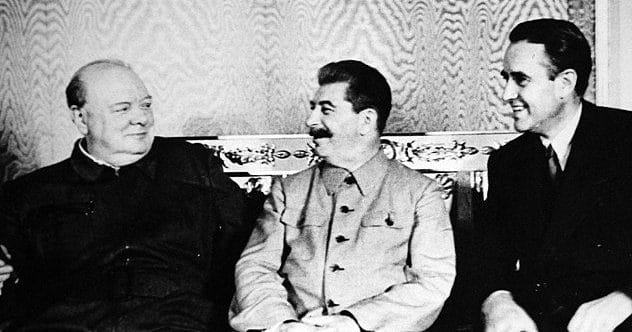Gift-giving is an art, especially when famous figures are involved. Throughout history, presents exchanged by leaders, celebrities, and even notorious criminals have often carried deep, symbolic meanings. These weren’t just simple tokens; they were statements, sometimes subtle, sometimes shockingly direct. Whether meant to woo, warn, celebrate, or deceive, the messages hidden within these gifts can be truly astounding. Let’s unwrap the stories behind ten such fascinating offerings.
10. Pushinka the Puppy: A Cold War Taunt
In 1961, amidst the Cold War, Soviet Premier Nikita Khrushchev sent a puppy named Pushinka to U.S. President John F. Kennedy. Pushinka was the offspring of Strelka, one of the dogs the Soviets had successfully sent into space and returned alive. This cute gift was widely seen as a way for Khrushchev to subtly gloat about the USSR’s lead in the space race. Kennedy reportedly responded by doubling down on the U.S. goal to land a man on the moon, a feat achieved in 1969.
9. The Corpse Doll: A Director’s Dark Message
Alfred Hitchcock, the master of suspense, was known for his chilling films. His behavior off-screen could also be disturbing. During a troubled working relationship with actress Tippi Hedren, Hitchcock gifted a miniature doll looking like Hedren, nestled inside a tiny coffin, to Hedren’s six-year-old daughter, Melanie Griffith. This macabre present was likely an expression of Hitchcock’s bitterness towards Hedren for rejecting his advances. It was a truly unsettling gesture from a famed director.
8. The Resolute Desk: A Transatlantic Token
A gift symbolizing goodwill between nations, the Resolute Desk was presented to U.S. President Rutherford B. Hayes by Britain’s Queen Victoria in 1880. This ornate desk, which has been used by many U.S. presidents in the Oval Office, was crafted from the timbers of the British ship HMS Resolute. The United States had played a role in rescuing the ship from the Arctic Ocean in 1855, making the desk a powerful symbol of mutual respect and shared history.
7. A Book Bound in Human Skin: A Highwayman’s Respect
One of the most bizarre symbolic gifts involved the infamous highwayman James Allen. Condemned to death in 1837, Allen dictated his memoirs and requested they be bound in his own skin. This grisly volume was to be given to John Fenno Jr., the man whose testimony led to Allen’s death sentence. Shockingly, Allen intended this as a sign of respect for Fenno. The practice, known as anthropodermic bibliopegy, was not entirely uncommon at the time.
6. The Dead Fish: A Mafia Warning
Some symbolic gifts are less about subtlety and more about direct threats. The Mafia has famously used a dead fish to convey the message that someone will “sleep with the fishes” if a warning is ignored. In a real-life incident in 2003, a reporter investigating alleged Mafia links to actor Steven Seagal found a dead fish, a rose in its mouth, and a note saying “Stop” in her car. The symbolism was chillingly clear.
5. Crystal Caravel Chandeliers: A Sailor’s Gratitude

Sometimes gifts are made to a place rather than an individual, yet still carry deep symbolism. The Basilica of Guadalupe and Church of San Francisco in San Luis Potosí, Mexico, house a remarkable pair of crystal chandeliers shaped like caravels (ships used in colonial expeditions). Crafted in 1788, legend says they were commissioned by sailors. They believed Saint Francis of Assisi had saved them from a shipwreck, and these ex-votos (tributes) were their way of expressing profound gratitude.
4. Stalin’s Sword: An Ally’s Acknowledgment
The Sword of Stalingrad was a ceremonial longsword commissioned by British King George VI for Soviet leader Joseph Stalin. Winston Churchill presented this ornate weapon to Stalin during World War II. It symbolized Britain’s gratitude for the Soviet Union’s pivotal victory at the Battle of Stalingrad in 1943, a turning point in the war against the Axis powers. Ironically, the wartime alliance soon gave way to the Cold War rivalry.
3. Replica of the Great Seal: A Spying Ploy
Not all gifts are what they appear to be. In 1945, a hand-carved wooden replica of the Great Seal of the United States was presented to U.S. Ambassador Averell Harriman by a Soviet youth organization. It seemed a gesture of friendship. However, concealed within was an advanced listening device, or “bug,” invented by Leon Theremin. This Trojan horse of diplomacy hung in the ambassador’s office for seven years before the sophisticated spy tech was discovered in 1952.
2. Al Capone’s Cherry Trees: A Gangster’s Gratitude
Cherry blossoms symbolize rebirth and the fleeting nature of life. This made the two Japanese weeping cherry trees donated by notorious crime boss Al Capone to Union Memorial Hospital in Baltimore a surprisingly fitting gift. Released from Alcatraz in 1939 due to ill health, Capone was treated at this hospital when others turned him away. The trees were a genuine thank you for the compassionate care he received. One of these trees, or its descendants, still stands today.
1. Miniature Gold Ship: Anne Boleyn’s Pledge
Before her tragic end, Anne Boleyn and King Henry VIII shared a passionate courtship. In 1527, while Henry was still married to Catherine of Aragon, Anne gifted him a miniature gold ship. Inside, a lone damsel was depicted being tossed about. At the time, Henry was seeking to annul his marriage to marry Anne, placing her in a precarious position. Ships often symbolized protection. Historians suggest this gift represented Anne’s submission to Henry’s will and her resolution to marry him, despite the turmoil.
These tales show that a gift is rarely just an object. It can be a carefully chosen symbol, carrying messages of power, love, respect, or even deception. The stories behind these famous presents remind us to look beyond the surface and consider the deeper meanings that might be hidden within.
What other symbolic gifts from history do you find fascinating? Share your thoughts and examples in the comments below!










